Speech Sustainable Growth in Australia
Introduction
A lot has happened in Australia since I spoke at the corresponding BZW seminar last September, most of it good.
The best news is that the Australian economy is now growing quite strongly and that inflation is under control. I suspect you know this already; these days economic news – good and bad – travels quickly.
Indeed, in London a few weeks ago I spoke to several groups of funds managers with investments in Australia and I made a point of asking them what it was that concerned them most about Australia. With only slight exaggeration, the common answer can be summarised as ‘too much good news’!
Today it is not so much a matter of whether the news about Australia is good or bad (as it was a year ago), but rather what all the ‘good’ news means.
The short answer is that it can mean different things to different people. For investors in Australian bonds, for example, it appears to raise some doubts about our ability to manage the good times without recurring boom and bust conditions.
Others will see the same things differently. For businesses (large and small), for example, it means the best economic outlook in decades. Confidence and profitability are at record levels, and businesses of all kinds are poised to take advantage of the projected world recovery.
For unemployed workers – and while the numbers are declining, 10 per cent of the workforce is still unemployed – it means the best chance in a long time of finding a job. Sustained economic growth is inherently the best cure for the economic and social ills of high unemployment.
Governments – and central banks – have to weigh up the interests and aspirations of all groups in the community in coming to judgments about economic policy. It is my view that, properly managed, current trends can deliver a long period of strong, non-inflationary growth.
I will return to some particular aspects of this management task later in my talk. But first I should enlarge on what is happening in the ‘real’ economy: it is those developments which ultimately determine the returns to everyone who lives, works and invests in Australia.
Economic Recovery and Outlook
In terms of output, the Australian economy bottomed in mid-1991 and has been recovering since then.
It has been a fairly gradual recovery but the pace has quickened recently, to a very respectable rate of 4 to 5 per cent. It has been a fairly traditional recovery, being led by consumer spending, housing investment and public spending.
It is a recovery with many quality features. In particular, productivity appears to be growing strongly, while export volumes – notwithstanding the slack world economy – have increased by more than 20 per cent over the past three years. Inflation has averaged less than 2 per cent a year through the recovery.
I find it hard to accept that 4 to 5 per cent growth and 2 per cent inflation, which we now are experiencing, is ‘too much good news’. That growth rate is above what can be sustained long term, but it is sustainable for a time because we started with considerable spare capacity. This is being taken up at a measured pace; it has taken three years for output to rise 10 per cent above its trough in this recovery, compared with only a year and a half in the early 1980s recovery.
Compared with the US, where unemployment (at 6 per cent) is close to its effective floor, Australia has no real pressures on labour supplies. We do, however, need a pick-up in business investment soon to head off possible physical capacity constraints a year or two out. In the meanwhile, businesses are using their existing plant more efficiently, and a lot more output is being squeezed out of it.
The scene is set for a strong recovery in business investment. Sales are rising, company profits are the highest they have been for 25 years, and cash flows are strong. Moreover, banks in Australia, which are now returning to better levels of profitability and have an average capital ratio of 12 per cent, are well placed to assist. All business surveys point to the high levels of confidence and investment intentions.
Timing is always difficult to predict but a large increase in investment in new plant and equipment is anticipated over the year ahead. This is not expected to cause aggregate demand to grow too strongly; even with a substantial increase in business investment, the overall pace of growth is forecast to remain in the 4 to 5 per cent range (Graph 1). It is no secret, however, that we would like to see the on-going strength in housing lending ease off as business credit picks up.
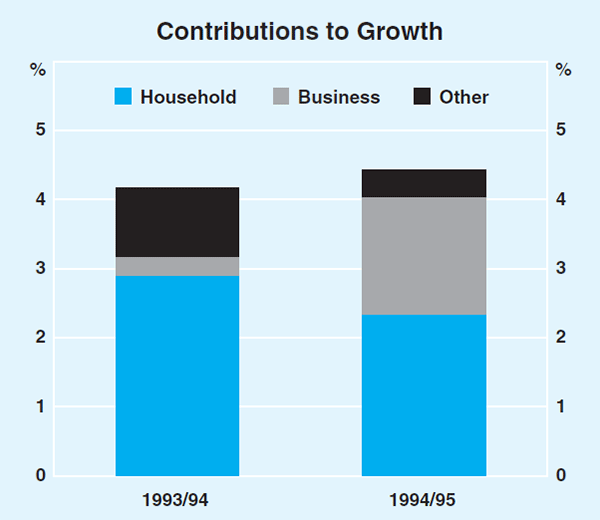
Current Account Deficits and Foreign Debt
The two major perceived threats to keeping Australia on the narrow path of sustained growth are blowouts in the current account and inflation. How real are these threats?
Australia has always run a significant current account deficit, that being, in effect, the channel through which we have drawn on foreign savings to help finance our development. The ‘brooding pessimism’ about Australia's external sector resurfaced in the 1980s, when the deficit averaged close to 5 per cent of GDP, about double the long-term average. The underlying situation, however, has shown some improvement since the mid-1980s when the balance on goods and services started to improve (Graph 2). This balance needs to be held around zero (or better) to stabilise the foreign debt to GDP ratio (Graph 3).
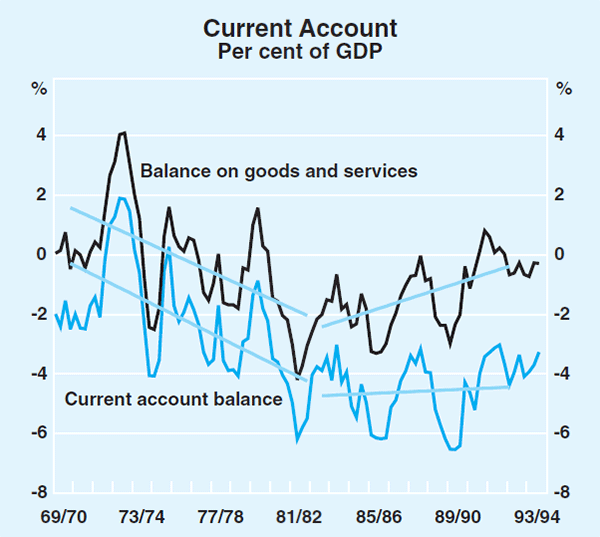
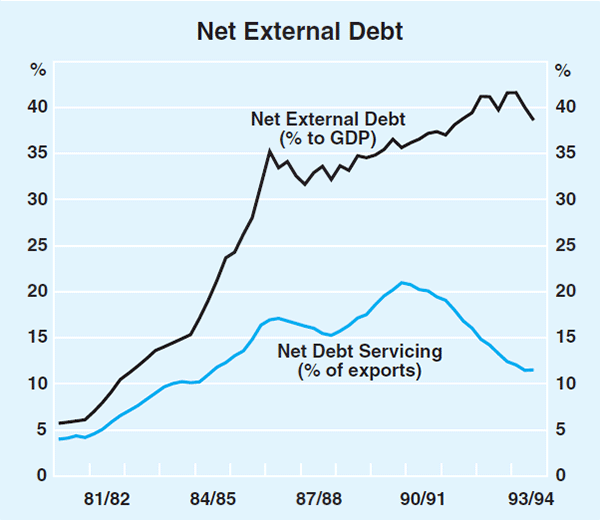
The current account deficit can be viewed from two perspectives. One focuses on export and import performances, and the other on the national savings/investment balance. As to the former, imports and exports have both increased relative to GDP as Australia has become more integrated with the rest of the world. The strong export story which I outlined last year, built around the strength of manufacturing and service exports, remains true today. In part, it reflects the expansion of the Asian economies, which are now the destination for almost two-thirds of Australia's total exports.
Last year, the current account deficit represented about 3¾ per cent of GDP. It is forecast to increase a little in 1994/95, mainly for cyclical reasons. Strong domestic growth will add to the demand for imports, especially of capital equipment. Rises in interest rates will also add to debt service costs. On the other hand, stronger world growth should bring some offsets through higher export volumes and prices.
Seen in terms of an excess of investment over domestic savings, a structural change in the current account deficit requires a counterpart change in the domestic savings/investment imbalance. All I want to say about this important issue today is that policy makers understand the need to increase domestic savings. To that effect, steps have been taken to encourage private savings, particularly through compulsory superannuation arrangements, and (what is quantitatively more important) to raise public savings through reductions in the budget deficit.
By international standards, Australia's budget deficit is not high. This year, it is estimated to be about 3 per cent of GDP, or about half the average for member countries of the European Community. The Australian Government, moreover, is committed to reduce its budget deficit to under 1 per cent of GDP by 1996/97. I am hopeful that it will be able to do better than that, and I am encouraged in this view by recent comments by the Treasurer that, if necessary, additional measures will be taken to reduce the deficit.
Such comments are comforting to a central banker because, when the time comes to pull on the reins to keep the economy on a sustainable path, it is helpful for fiscal – as well as monetary – policy to be involved.
However it is viewed, the current account deficit should not be a major constraint over the years ahead. At the same time, there is still some unfinished business for Australia in this area.
Inflation
A more serious threat, in the eyes of some people, is a blowout on inflation.
Seen in historical perspective, it is wrong to view Australia as a chronically inflation-prone country (Graph 4). Inflation shot up during the Korean War but that passed quickly, to be followed by roughly two decades of low average inflation and good growth. This record was broken in the 1970s by oil and commodity price shocks, exacerbated by policy shortcomings. In the 1980s, progress in winding back inflation was interrupted by the 35 per cent depreciation of the $A in the middle of the decade. Yet, in the years of strong growth in the late 1980s before the onset of recession), Australia's rate of inflation had begun to ease back.
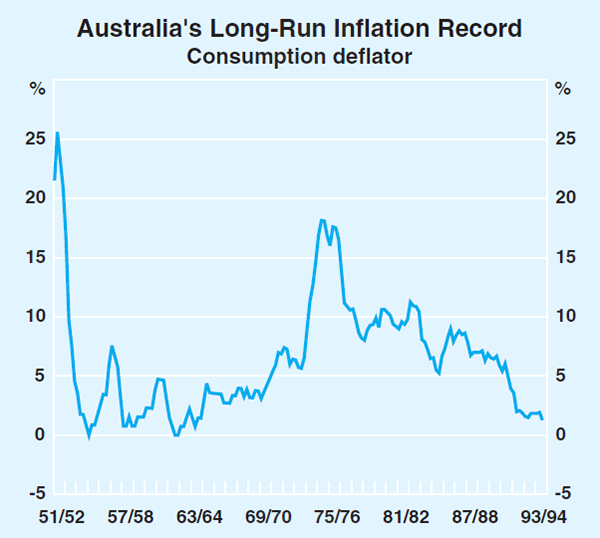
Why are our prospects for maintaining low inflation better now than in the 1970s and 1980s? The short answer is that the two main culprits in the past – excessive wage outcomes and exchange rate problems – are now seen as less threatening.
Under Australia's earlier centralised wage system, wage increases in one sector tended to pass quickly to other sectors. That system helped to deliver substantial wage restraint during the second half of the 1980s but at other times (as in the 1970s and early 1980s) it served to spread wage pressures throughout the economy. It also provided few linkages between wage outcomes and enterprise level productivity, and hence little incentive for employers and employees to negotiate ‘win/win’ changes to work practices.
With the shift from centralised increases towards enterprise based adjustments, the earlier linkages have been broken and wage increases are coming to depend more on the productivity performance of individual enterprises. The new system is still evolving, and it has had its teething troubles. It does not eliminate the dangers of excessive wage claims, but it does embody the prospect of a less inflation-prone wages system.
This prospect is enhanced by the concern for price and cost competitiveness which now pervades all businesses (including government enterprises) in Australia. In part, it reflects the greater exposure of the economy to international competition, along with associated attitudinal changes. One catalyst was the reduction in protection from imports, which has been halved over the last decade. Another is the mobility of investment and production processes, which has concentrated the minds of all the parties with an interest in attracting and keeping businesses in Australia. Global linkages also have brought improved practices, such as benchmarking.
These structural and attitudinal changes can be seen in Australia's better macro productivity performance during the recovery. They are encapsulated also in what has been described as ‘the renaissance of manufacturing’: over the past year, that sector's output rose by 10 per cent; productivity rose by 8 per cent; and exports increased by 20 per cent.
The bottom line of all this is that wage increases have been relatively modest in Australia for some time now. Increases in earnings have averaged 3 per cent per annum over the past three years. Some additional pressures can be expected as the recovery consolidates, but the slack in the labour market, lower inflationary expectations, and the changes mentioned earlier (in exposure to international competition, in the wages system, and in attitudes), suggest that a serious blowout is unlikely.
This leaves the other major potential threat of a severe and sustained currency depreciation. As noted earlier, the 35 per cent depreciation of the $A in the mid-1980s was accompanied by a sharp rise in inflation (Graph 4).
Around the time of the corresponding seminar last September, the Australian dollar reached a low in trade-weighted terms of 47.1, bringing the fall over the preceding two years to about 20 per cent. Such a fall, if it had been sustained, might have brought some unwanted inflationary pressures through higher import prices – which helps to explain why the Reserve Bank intervened heavily in the foreign exchange market at the time, and also considered raising interest rates to support the exchange rate. In the event, part of this fall was reversed fairly quickly, with the trade-weighted index appreciating by about 14 per cent between the end of September 1993 and early February 1994. The $A has remained quite firm since then, notwithstanding the turbulence in international bond markets (Graph 5).

The Reserve Bank is not in the business of forecasting exchange rates, but the odds are that the pressures over the next year or so are more likely to be upwards than downwards. The likelihood is that commodity prices will improve further on the back of the projected recovery in world industrial output in 1994 and 1995. Australia's export base has diversified over recent years but commodities still comprise more than 60 per cent of the total, and we tend to benefit more than most countries from higher commodity prices.
Looking ahead then, neither wages nor the exchange rate appears likely to be a major source of unwinding of the substantial gains made on inflation in recent years.
I would add two further reasons for confidence about the inflation outlook. The first is that our starting point is the best we have had for two decades, both in terms of actual inflation and inflationary expectations. The second is the policy commitment to keep inflation in the 2 to 3 per cent range, which we equate with reasonable price stability. It seems that more than three successive years of sub-2 per cent inflation is necessary to re-establish Australia's credentials as a low inflation country, but those who doubt our policy resolve run the risk of missing an important watershed.
Developments in Bond Markets
Some of you might be thinking that my assessment of the outlook for inflation in Australia is at odds with recent assessments by bond markets. It is, at least to the extent that those latter assessments continue to see Australia as an inflation-prone country. But I think the general issues here are more complex than such comparisons suggest.
Long-term bond yields everywhere have risen over the past six months, but the rise in Australia has been greater than elsewhere (Graph 6). This suggests that both general and country specific factors have been at work. The move by the US Fed to raise interest rates in early February (and subsequently) appears to have been the trigger for yields to rise globally. It is as though bond holders suddenly realised that, with strong growth occurring in the US and gathering signs of recovery in Germany and elsewhere, the outlook had changed: with stronger world activity would come additional pressures on inflation, and increased demands for capital.
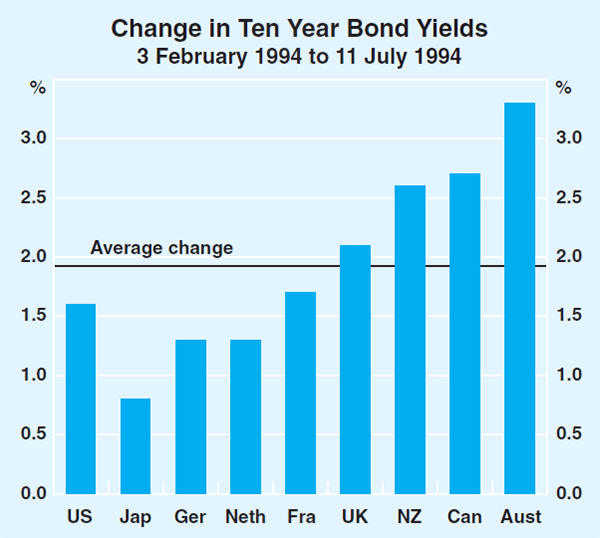
Compared with the much more subdued outlook a year earlier, it therefore made sense for this improved outlook to be accompanied by some rise in interest rates. Whether that improvement was sufficiently dramatic to explain the sea-change in sentiment that occurred, particularly in the absence of any signs of accelerating inflation, are matters which economists can debate. But they are not matters which bond holders pause to debate in the frenzy of a falling market! Faced with large scale uncertainty, the general reaction (especially in highly leveraged markets) is to pull back – to go short – and this is what we have seen. Modern communications and market linkages ensured that the uncertainty and selling spread quickly to all markets.
If something like this explains what has happened globally, what explains the larger than average increases in Australia (where 10-year bond yields have risen more than 300 basis points since their low points in January this year)? The factors usually mentioned are Australia's already fast rate of growth, and the prospect that rising commodity prices would stimulate Australia more than most countries, pushing the growth rate even higher. There seems also to be a view that the authorities will be slow to tighten monetary policy in response to such developments.
Implications for Monetary Policy
The message from financial markets on interest rates seems to be that we should ‘act, and act now’. Some people have interpreted the absence of any policy response as some attempt to ‘stare the market down’, and to prove that no interest rate increase is necessary.
That is not the way we see it. We have a firm commitment to price stability and we accept the need for interest rates to be adjusted during the cycle in a forward looking way. It is clear that the economy now is growing rather more strongly than it was a year ago, when interest rates were still being reduced to encourage the recovery. The interest rate settings appropriate to those circumstances, however, will not remain appropriate as the recovery consolidates.
But the economy is not about to burst out of its current 4 to 5 per cent growth range, and there are few signs that wage or other cost increases are accelerating. Indeed, there is every reason to believe that current growth and inflation rates will be sustained in 1994/95; given the lags involved, the policy tightening, when it comes, will help to sustain strong, non-inflationary growth over a longer period.
All this has been stated repeatedly, and for some time, by both the Reserve Bank and the Government. There has been a clear commitment that policy would be tightened when this was judged necessary to keep the economy on a sustainable path, and to deliver the durable recovery needed to get unemployment back to acceptable levels.
Seen in terms of this framework, I suspect there is more common ground between the markets and the authorities than has been acknowledged. Apart from the obvious point that the authorities must take a much broader view of economic developments than the markets, it largely comes down to a matter of judgment about timing.
As to that, I think the markets have been too ready to believe the worst on inflation. Moreover, while no country which relies as heavily on foreign capital as Australia does can ignore what the markets are saying, the authorities naturally prefer to take policy actions on the basis of factors affecting their own domestic economy.
I have said, on a number of occasions, that interest rates will have to rise as the recovery proceeds. The Government agrees. No-one should doubt this resolve.
